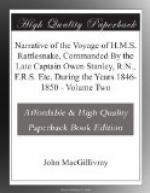Pachyrhynchus nigerrimus, maculis parvis squamosis plurimis viridiscenti-albidis.
Habitat: Pariwara Islands, New Guinea. Four specimens.
Head between the eyes somewhat rugose, some of the rugose punctures with pale greenish white scales; an abbreviated longitudinal impressed line down the front. Beak short and thick (somewhat as in Pachyrhynchus cumingii, Waterhouse). Thorax irregularly and somewhat coarsely punctured, the sides somewhat wrinkled in front, the punctures scaled, a triangular depression on the posterior part of thorax, the bottom is covered with scales, at least in some specimens, and there are three spots similarly scaled and placed somewhat transversely: the Elytra with eight to ten punctured lines, running somewhat irregularly, especially towards the sides, each elytra with ten, twelve, or more spots of scales, arranged longitudinally in spots on the sides, and largest towards the end. Underside of the mesothorax and metathorax with many greenish scales. Legs thick, polished, and with scattered grey hairs proceeding from the punctures.
I have named this somewhat mourning Pachyrhynchus after Captain Owen Stanley and his father, the late venerable Bishop of Norwich and President of the Linnean Society. Both of these gentlemen were fond of natural history, especially the father, who was a good observer of the habits of birds. The son, Captain Owen Stanley, was an accurate, though not very practised draughtsman; and I recollect with pleasure his pointing out to me, at one of the soirees at Brook Street, a volume of sketches (coloured) made by him on one of his voyages, in which objects of natural history were ably introduced. He encouraged natural history researches.
HYMENOPTERA.
Trigonalys compressus. Smith. Trans. Ent. Soc. Lond. n. ser. 1. p. —— pl. 16. f. 2.
Sphex compressa. De Geer. Mem. 3.
Trigonalys bipustulatus. Smith (olim) Ann. and Mag. Nat. Hist. 7 1851.
Habitat: Nest of Polistes lanio. Brazil.
Among the Hymenoptera, few genera have created greater dispute than the anomalous genus Trigonalys of Westwood. Mr. Macgillivray one day brought to the British Museum the nest of a Brazilian Polistes. My friend, Mr. Frederick Smith, is well known for his profound knowledge of the Hymenoptera, Exotic and British, which, though he has studied them ONLY fourteen years, are better known to him, perhaps, than to any other living Entomologist; the instant that he looked at the nest, he exclaimed, “Why, here is Trigonalys!” and certainly a large, black-headed creature, not very like Polistes, protruded from one of the cells. Mr. Smith, on the 7th April, 1851, communicated this piece of information to the Entomological Society of London, and in their Transactions his brief memoir was lately printed. I cannot do better than give it in Mr. Smith’s own words. Mr. Smith, subsequently to the reading of the paper, ascertained that the species had been described in the great work of De Geer, a book of which it would be well to have a condensed new edition. Mr. Smith says:




